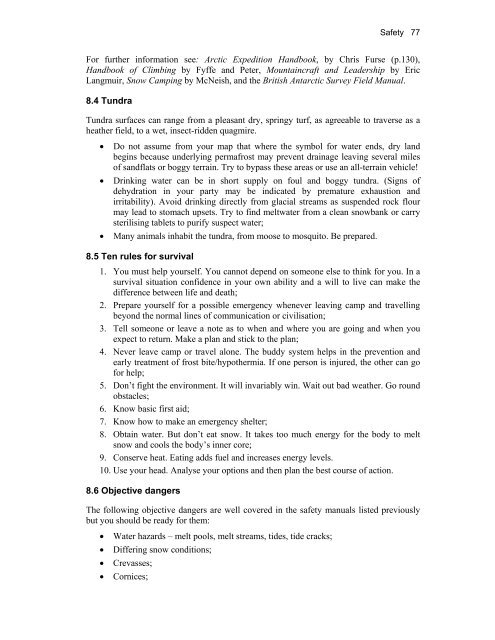Edited by Rachel Duncan 4th Edition ISBN 0-907649-91-2 London ...
Edited by Rachel Duncan 4th Edition ISBN 0-907649-91-2 London ...
Edited by Rachel Duncan 4th Edition ISBN 0-907649-91-2 London ...
You also want an ePaper? Increase the reach of your titles
YUMPU automatically turns print PDFs into web optimized ePapers that Google loves.
Safety 77<br />
For further information see: Arctic Expedition Handbook, <strong>by</strong> Chris Furse (p.130),<br />
Handbook of Climbing <strong>by</strong> Fyffe and Peter, Mountaincraft and Leadership <strong>by</strong> Eric<br />
Langmuir, Snow Camping <strong>by</strong> McNeish, and the British Antarctic Survey Field Manual.<br />
8.4 Tundra<br />
Tundra surfaces can range from a pleasant dry, springy turf, as agreeable to traverse as a<br />
heather field, to a wet, insect-ridden quagmire.<br />
• Do not assume from your map that where the symbol for water ends, dry land<br />
begins because underlying permafrost may prevent drainage leaving several miles<br />
of sandflats or boggy terrain. Try to <strong>by</strong>pass these areas or use an all-terrain vehicle!<br />
• Drinking water can be in short supply on foul and boggy tundra. (Signs of<br />
dehydration in your party may be indicated <strong>by</strong> premature exhaustion and<br />
irritability). Avoid drinking directly from glacial streams as suspended rock flour<br />
may lead to stomach upsets. Try to find meltwater from a clean snowbank or carry<br />
sterilising tablets to purify suspect water;<br />
• Many animals inhabit the tundra, from moose to mosquito. Be prepared.<br />
8.5 Ten rules for survival<br />
1. You must help yourself. You cannot depend on someone else to think for you. In a<br />
survival situation confidence in your own ability and a will to live can make the<br />
difference between life and death;<br />
2. Prepare yourself for a possible emergency whenever leaving camp and travelling<br />
beyond the normal lines of communication or civilisation;<br />
3. Tell someone or leave a note as to when and where you are going and when you<br />
expect to return. Make a plan and stick to the plan;<br />
4. Never leave camp or travel alone. The buddy system helps in the prevention and<br />
early treatment of frost bite/hypothermia. If one person is injured, the other can go<br />
for help;<br />
5. Don’t fight the environment. It will invariably win. Wait out bad weather. Go round<br />
obstacles;<br />
6. Know basic first aid;<br />
7. Know how to make an emergency shelter;<br />
8. Obtain water. But don’t eat snow. It takes too much energy for the body to melt<br />
snow and cools the body’s inner core;<br />
9. Conserve heat. Eating adds fuel and increases energy levels.<br />
10. Use your head. Analyse your options and then plan the best course of action.<br />
8.6 Objective dangers<br />
The following objective dangers are well covered in the safety manuals listed previously<br />
but you should be ready for them:<br />
• Water hazards – melt pools, melt streams, tides, tide cracks;<br />
• Differing snow conditions;<br />
• Crevasses;<br />
• Cornices;

















